
Executive Summary
In February of 2019, the Pharmacy team performed an in-depth analysis of current the Greater Baltimore Medical Center (GBMC) order set related to heparin drip for efficacy and outcomes. Noting the 22% inappropriate protocol selection and the variations in reaching therapeutic activated partial thromboplastin time (aPTT) ranges as measured in hours, further investigation was recommended by the Clinical Pharmacy team to identify opportunities to improve patient care and outcomes as it related to heparin drips. Time to therapeutic range (TTR) was selected as the outcome metric to best replicate INR outcome measurement used to measure discharge criteria. Using Failure Modes and Effects Analysis (FMEA) methodology, the Project Team combined Epic analysts with key clinical stakeholders from ordering providers, pharmacists, and nursing over several months to rebuild the EHR Pharmacy to Dose Heparin order set through the mitigation of over 100 potential failure points, incorporating end-to-end testing from point of order entry through delivery and titration of the heparin drip via IV pump at the bedside. Through this process, the need for extensive re-education related to the pharmacy verification process and nursing IV pump use was noted and completed prior to the October 2019 roll out of the improved order set. Since July 2019, we’ve seen an increase in our 24 hours-or-less TTR of 162%, despite the complexities surrounding COVID-19 coagulopathy. As part of the evolving COVID-19 best practices, we noted highs and lows in reaching our 24-hour TTR, which speaks to the peaks and valleys of prevalence in COVID-19 diagnoses from March 2020 through the present.
Define the Clinical Problem and Pre-Implementation Performance
As part of the ongoing work by GBMC’s Pharmacy and Therapeutics (P & T) Committee, a study of outcomes was completed and presented in February 2019 related to heparin drip protocols. Included in the study to determine efficacy were protocol usage, time to anticoagulation, literature review for best practice guidelines, and a comparison of aPTT and anti-Xa correlations between GBMC and other laboratories. Based on the manual chart review of 48 male patients with a mean age of 70.5 years and a variety of protocols applied, GBMC found 22% of patients were placed on inappropriate heparin drip protocols, of which deep vein thrombosis (DVT) and pulmonary embolism (PE) combined accounted for 50% of the failure to reach TTR. Knowing the impacts extended TTR has on outcomes and transitioning to oral anticoagulation, the P & T Committee recommended this project be prioritized to improve care of patients with VTE and PE events. This project would also monitor supratherapeutic events as defined by aPTT over 117 seconds (Smythe et al., 2016).
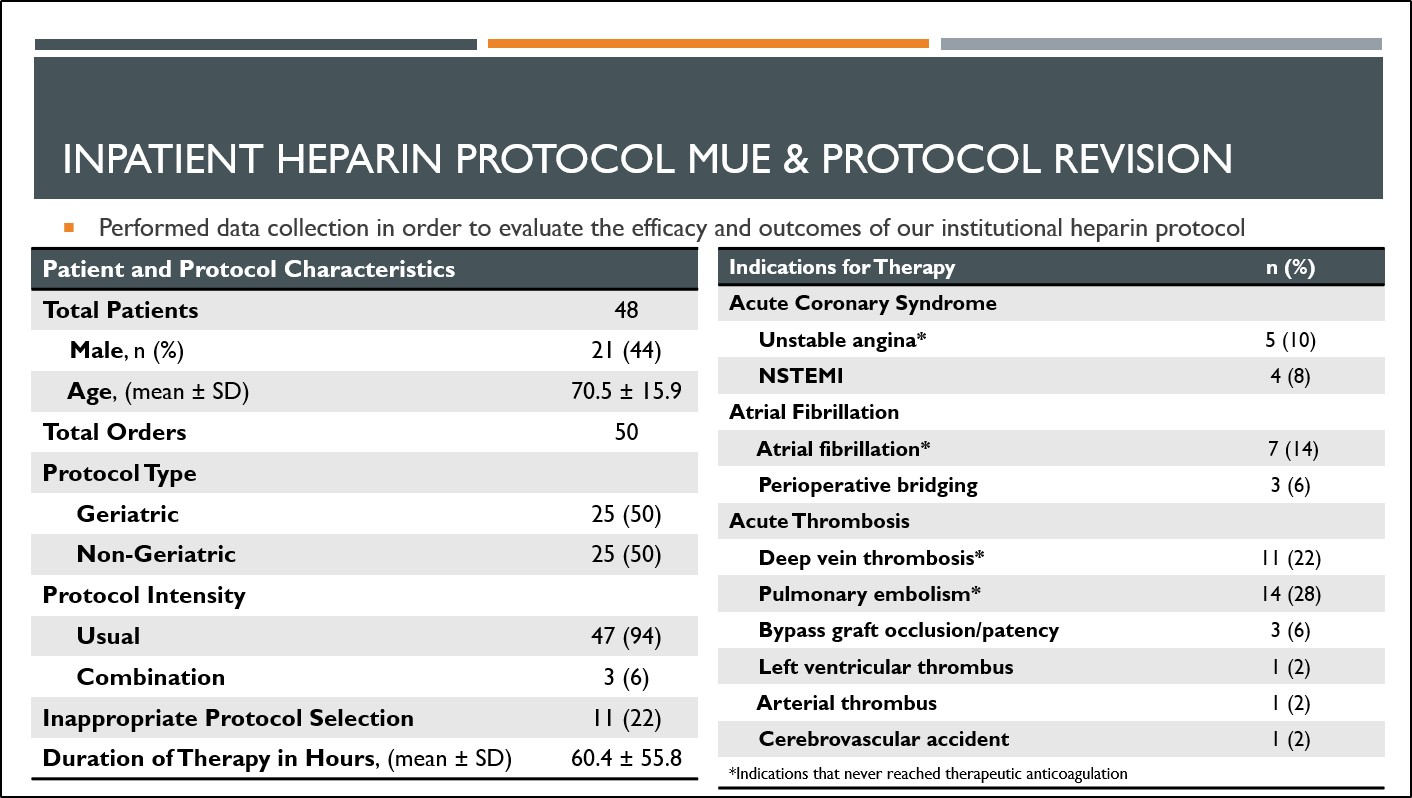
Source: Greater Baltimore Medical Center
The aPTT ranges used for benchmarking outcomes were based on CHEST recommendations related to the initial bolus and infusion rates in the treatment of DVT, VTE, PE, acute coronary syndromes, and atrial fibrillation related to perioperative bridging. The goal universally accepted for heparin drip protocols is TTR in 24 hours. Our population denominator identified patients with orders placed using the Pharmacy to Dose Heparin drip order set, with failure to reach TTR within 48 hours of initiation to be counted for informational purposes. Patients in the numerator were those as identified as in range in less than 24 hours. Patients excluded, though also counted for informational purposes, were patients with orders placed from the order set who had the drip discontinued less than 36 hours after initiation. GBMC’s performance goal was set to 30% of all-event TTRs, an improvement of 8% over the study sample.
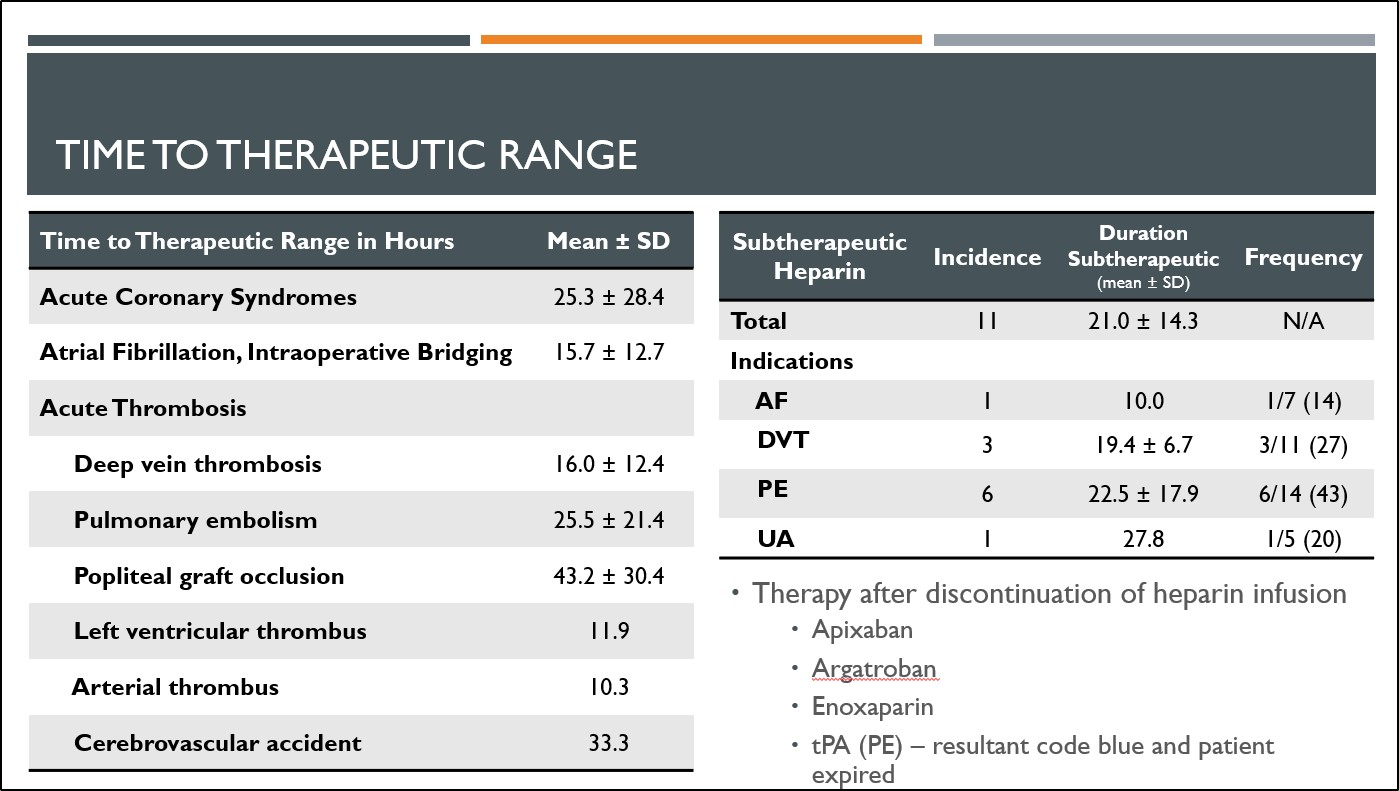
Source: Greater Baltimore Medical Center
Design and Implementation Model Practices and Governance
Providing care for critically ill patients using an unpredictable titrated medication requires strict oversight to ensure best outcomes. This project included key stakeholders from our critical care providers in the ED, ICUs, and Oncology, our pharmacy director, chief of staff, quality and patient safety, nursing and the Epic analysts representing each of those entities. Our Pharmacy, Order Set, and Nursing analysts worked closely with this project by using end-to-end testing to aid in the identification of 112 FMEA items: 9 provider items related to order placement; 30 pharmacy items covering verification of orders, protocol selection, and aPTT titrated dose changes; and 73 nursing items which were then further risk prioritized for action weighted 140 points or higher. The P&T Committee created a work group specifically for this project and regular updates were provided during those monthly meetings, as well as in the associated Order Set Committee, Nursing Advisory Council (NAC), and Inpatient Provider Advisory Committee (IPAC). Weekly meetings minutes provided updates as failure points were mitigated through system changes, such as critical lab result reporting for provider notification, dual verification sign-offs for pharmacists’ order verification, and hard stops added to the drug library in the IV pump for heparin dosing weight entry. Nursing Educator Chelsea Woodell worked with quality representatives Karena Meushaw and Kerrie Walsh to completely revamp nursing education around the IV drug infusion pump workflow. Nursing education completed training for over 500 nurses the month prior to go live, using a well-developed training environment to ensure workflows and documentation integrated into best practices at the bedside. Clinical Decision Support alerts were added with worklist tasks to ensure timely aPTT draws and every 2-hour documentation requirements were met.
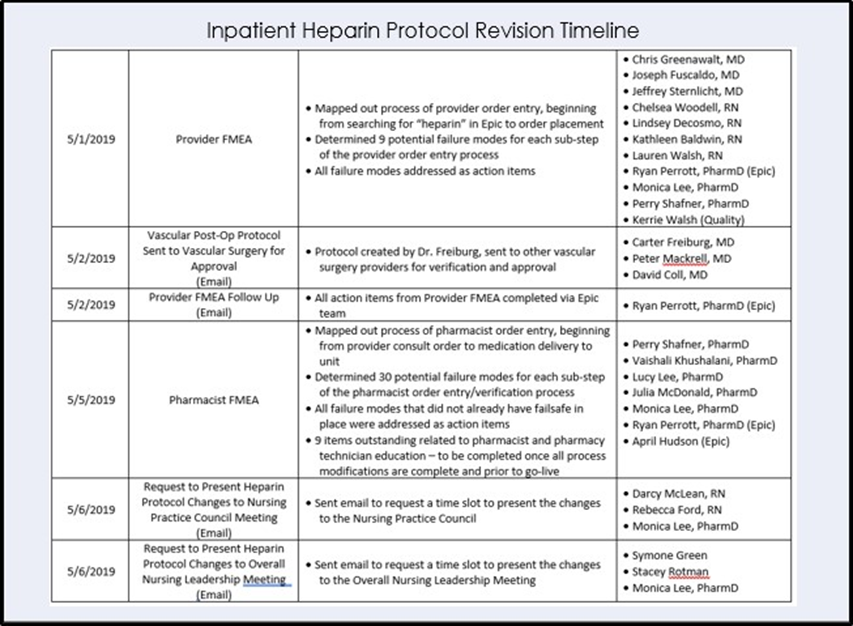
Source: Greater Baltimore Medical Center
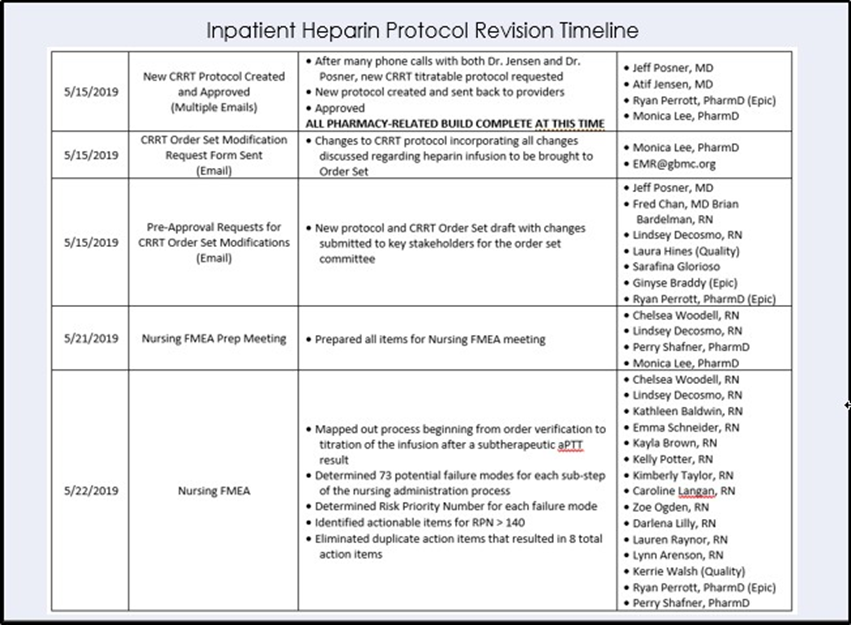
Source: Greater Baltimore Medical Center
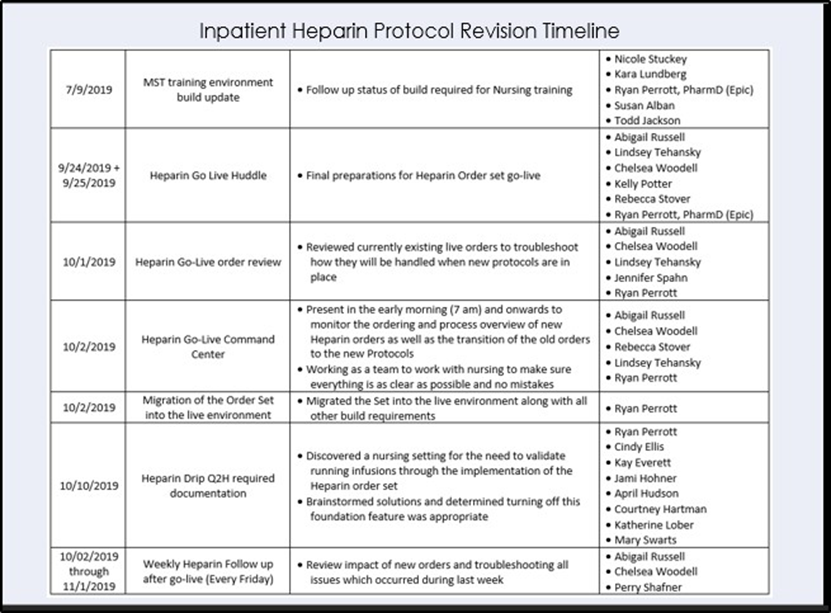
Source: Greater Baltimore Medical Center
Snapshot of FMEA Data Points
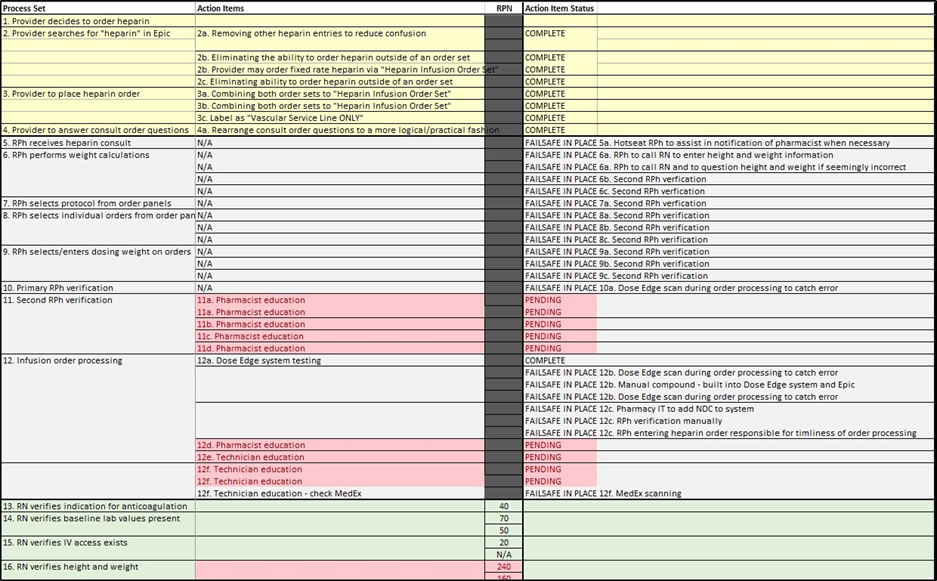
Source: Greater Baltimore Medical Center
Clinical Transformation enabled through Information and Technology

Source: Greater Baltimore Medical Center
Throughout the revamping process of the Pharmacy to Dose Heparin order set, adherence to heparin titration standards of care was the central project goal. Starting with provider order entry, automated orders for pharmacy, nursing, and lab were defaulted to allow the EHR system to provide efficiencies and safety points over the manual entry of orders. This physician order set reduces the turnaround time of drip initiation and titration through the capture of patient height and weights, orders for STAT and daily monitoring labs, and nursing tasks for patient education and provider notifications. Using the nurse input of height and weight, the pharmacy calculated ideal heparin dosing weight, which was displayed in with MAR administration workflows and programmed into the IV pump at the bedside.
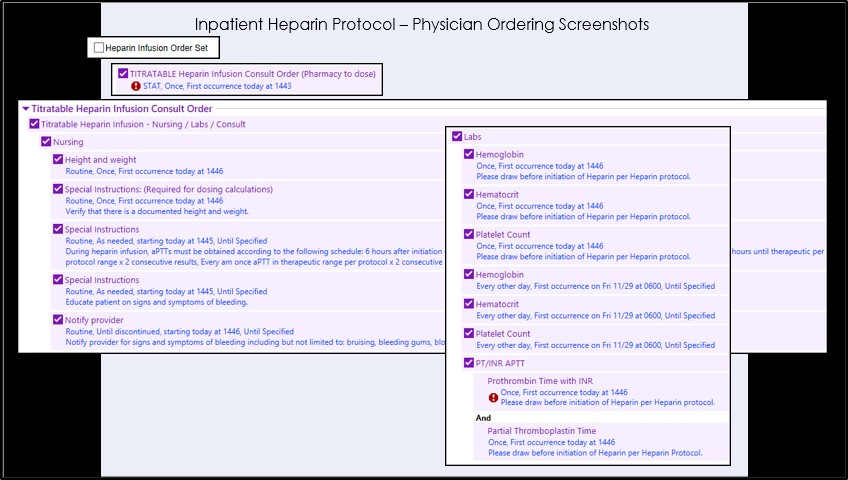
Source: Greater Baltimore Medical Center
The pharmacy consult order contained within the provider order set changed the protocol selection process to require dual pharmacist verification, reducing the potential of inappropriate protocol selection noted in the GBMC initial study. Required medication items are denoted with pre-selected medication orders. In-depth training and tip sheets were completed with all pharmacists prior to the October 1, 2019 go-live date.
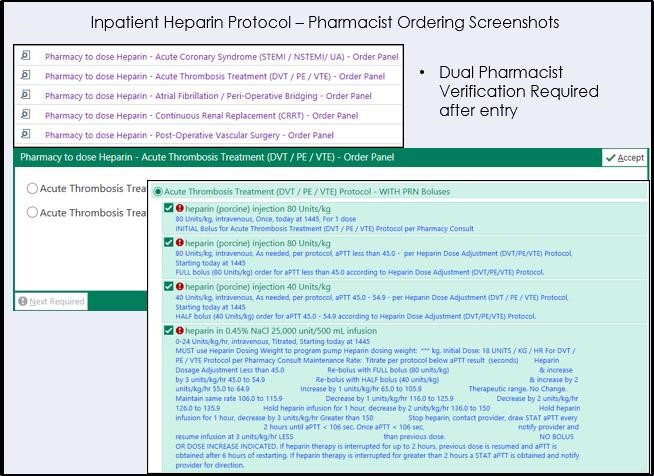
Source: Greater Baltimore Medical Center
Nursing workflows were the most radically changed in this project. Using information found during the FMEA sessions, MARs were redesigned to include most recent aPTT results in all titration administrations and the high risk associated with the drug required dual verification for medication documentation. Initial set up of the infusion pump required entry of the heparin dosing weight to be completed prior to medication initiation.

Source: Greater Baltimore Medical Center
Best Practice Alerts, Epic’s version of clinical decision support tools, were updated with color-coded protocol instructions. These BPAs also displayed the most recent lab results to ensure needed information was embedded within the nurses’ natural workflows.
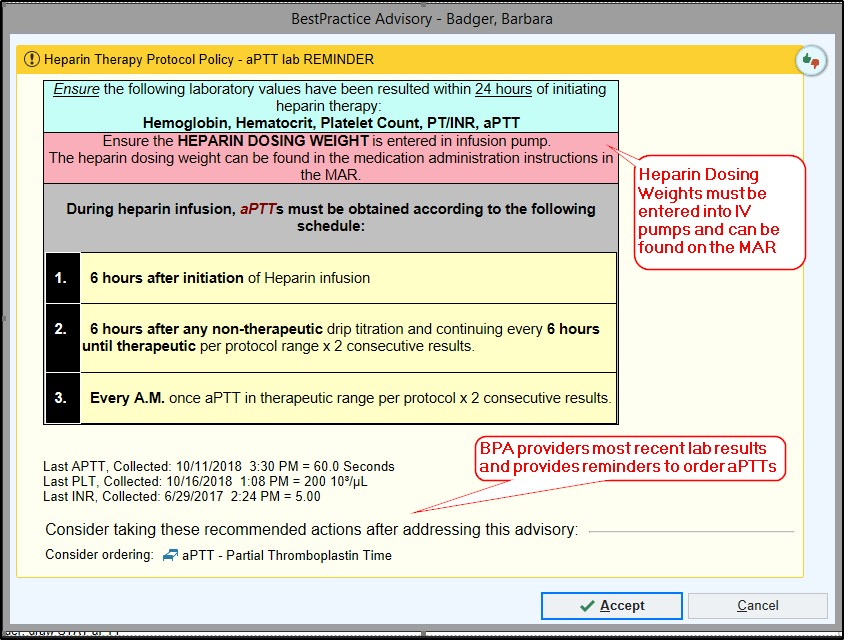
Source: Greater Baltimore Medical Center
Brain Tasks created guidance for nurses for the completion of every 2-hour documentation and timed lab draws. With the 70 various failure points identified during the FMEA process, the nursing leadership directed mandatory training for over 500 nurses prior to go-live. This request required updates to the EHR training environment and infusion pump training to ensure both were incorporated into seamless bedside care.

Source: Greater Baltimore Medical Center
Improving Adherence to the Standard of Care
Go-live for this project was set for October 1, 2019 and a command center was initiated to ensure Epic and all clinical staff had the resources needed to transition admitted patients to the new order set. Weekly post-go-live meetings were maintained until November 2019 to ensure issues were addressed in a timely fashion.
For evaluation of this project, we retrospectively chart abstracted time to therapeutic range in hours of the aPTT results, including patients with an active heparin drip order for at least 36 hours as our population denominator. The TTR goal was set as an industry benchmark, with ranges set by patient indications as recommended by CHEST (Smythe, 2016). Numerator patients were those who had aPTT results within the range of 24 hours or less, as defined by 2 consecutive results. Patients reaching aPTT within 36 hours of initiation of heparin drip were counted for informational purposes only. In October 2019, GBMC saw a 110% increase in usage of the Pharmacy to Dose Heparin order set, noting the initial go-live day did create an uptick as patients were transitioned from the old protocol. We also saw a 567% increase in the number of orders placed from the heparin drip protocol, primarily based on the automation of lab ordering and nursing task generation. This increase indicates the expected outcome of aggressive monitoring required to reduce poor outcomes of supratherapeutic aPTT results.
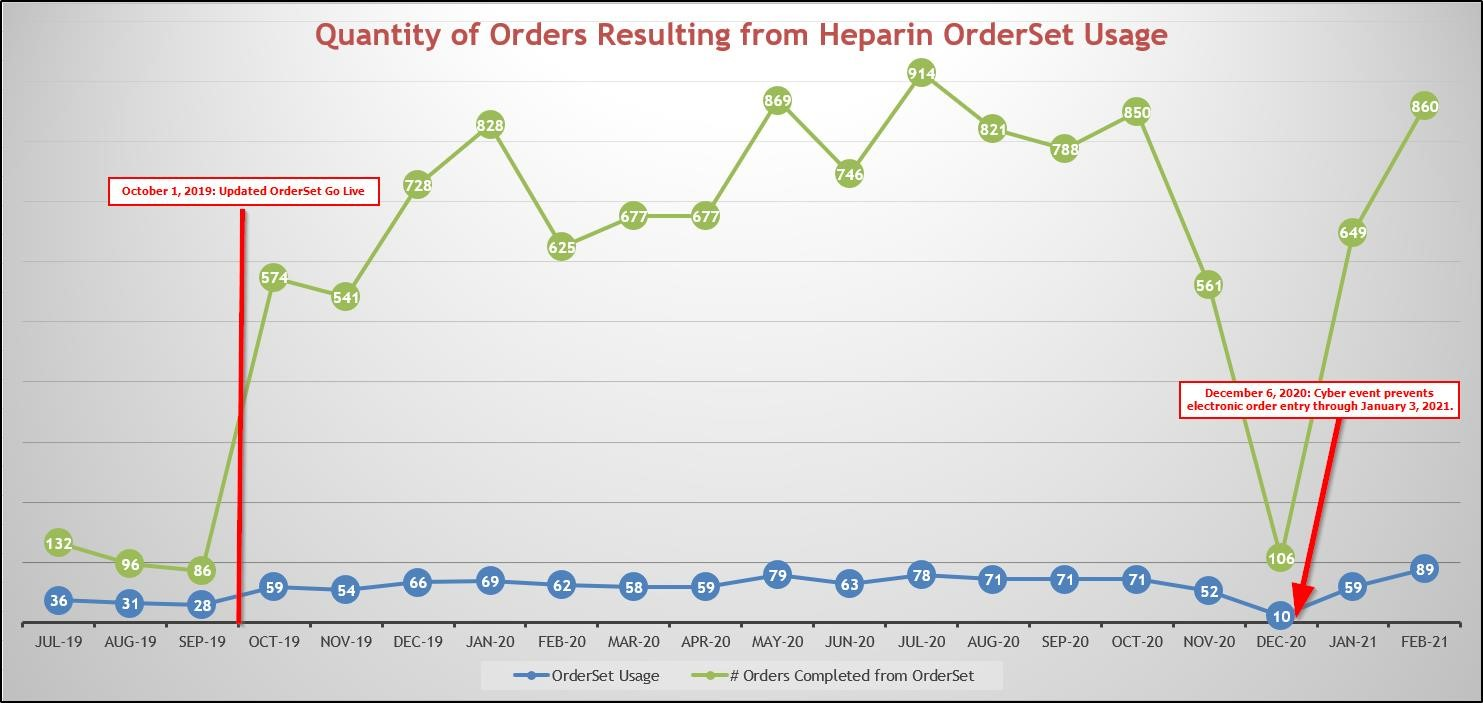
Source: Greater Baltimore Medical Center
Improving Patient Outcomes
In the first 3 months of use, GBMC noted a decrease in subtherapeutic aPTT results at 48 hours by 20%. As part of the baseline risk assessment done by the P&T Committee, using the old protocol resulted in a 41% increased patient risk of never reaching a therapeutic state. In December 2019, 87% of all patients on heparin drips did reach a therapeutic state, an improvement of 64% from October 2019. At the end of February 2021, we have seen an improvement of aPTT results within 24 hours of 340%.
During the spring and holiday period of 2020, GBMC noted increased times in reaching TTR, which correlates to the COVID-19 pandemic positivity rate and speaks to the complexity of treating the virus.

Source: Greater Baltimore Medical Center
Accountability and Driving Resilient Care Redesign
To monitor for best patient outcomes, reports were created to provide real-time identification of patients on heparin drips, including details related to the start date and age of order. An associated report for lab ordering and resulting of anti-Xa orders monitors patients for combination therapy outcomes. Contained within the report are the most recent lab results, order status to indicate those not yet finalized, and a condensed view of prior lab draw results. The P & T Committee report out monthly as sub-committee work relays unusual occurrences regarding incorrect order placement for Factor-Xa labs, identifying specific providers in need of education.
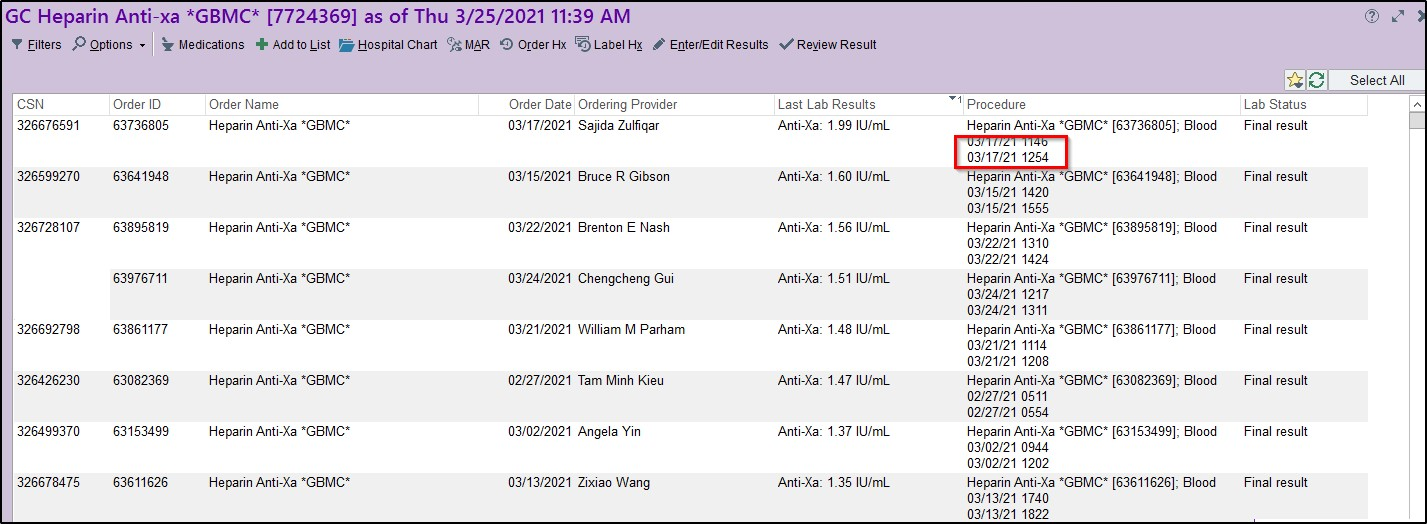
Source: Greater Baltimore Medical Center
Weekly reviews of patient outcomes and near miss/adverse event reporting related to the heparin protocols continue to be part of the post-implementation follow-ups to ensure identification of concern or new functionality is actionable in a timely manner. Data gathered and presented to the P &T committee monthly continues GBMC’s mission to commit to continuous cycles of process improvement and the integration of best practices.

Source: Greater Baltimore Medical Center
References
- O’Connor Smythe, M.A., Priziola, J., Dobesh, P. P., Wirth, D., Cuker, A., Wittkowsky, A.K. (2016). Guidance for the practical management of the heparin anticoagulants in the treatment of venous thromboembolism. Journal of Thrombosis and Thrombolysis 41(1), 161-186. https://dx.doi.org/10.1007%2Fs11239-015-1315-2
The views and opinions expressed in this content or by commenters are those of the author and do not necessarily reflect the official policy or position of HIMSS or its affiliates.
HIMSS Davies Awards
The HIMSS Davies Award recognizes the thoughtful application of health information and technology to substantially improve clinical care delivery, patient outcomes and population health.



